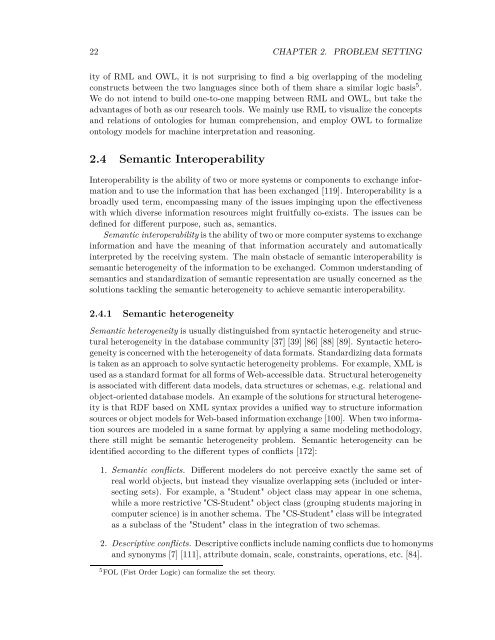Semantic Annotation for Process Models: - Department of Computer ...
Semantic Annotation for Process Models: - Department of Computer ...
Semantic Annotation for Process Models: - Department of Computer ...
Create successful ePaper yourself
Turn your PDF publications into a flip-book with our unique Google optimized e-Paper software.
22 CHAPTER 2. PROBLEM SETTING<br />
ity <strong>of</strong> RML and OWL, it is not surprising to find a big overlapping <strong>of</strong> the modeling<br />
constructs between the two languages since both <strong>of</strong> them share a similar logic basis 5 .<br />
We do not intend to build one-to-one mapping between RML and OWL, but take the<br />
advantages <strong>of</strong> both as our research tools. We mainly use RML to visualize the concepts<br />
and relations <strong>of</strong> ontologies <strong>for</strong> human comprehension, and employ OWL to <strong>for</strong>malize<br />
ontology models <strong>for</strong> machine interpretation and reasoning.<br />
2.4 <strong>Semantic</strong> Interoperability<br />
Interoperability is the ability <strong>of</strong> two or more systems or components to exchange in<strong>for</strong>mation<br />
and to use the in<strong>for</strong>mation that has been exchanged [119]. Interoperability is a<br />
broadly used term, encompassing many <strong>of</strong> the issues impinging upon the effectiveness<br />
with which diverse in<strong>for</strong>mation resources might fruitfully co-exists. The issues can be<br />
defined <strong>for</strong> different purpose, such as, semantics.<br />
<strong>Semantic</strong> interoperability is the ability <strong>of</strong> two or more computer systems to exchange<br />
in<strong>for</strong>mation and have the meaning <strong>of</strong> that in<strong>for</strong>mation accurately and automatically<br />
interpreted by the receiving system. The main obstacle <strong>of</strong> semantic interoperability is<br />
semantic heterogeneity <strong>of</strong> the in<strong>for</strong>mation to be exchanged. Common understanding <strong>of</strong><br />
semantics and standardization <strong>of</strong> semantic representation are usually concerned as the<br />
solutions tackling the semantic heterogeneity to achieve semantic interoperability.<br />
2.4.1 <strong>Semantic</strong> heterogeneity<br />
<strong>Semantic</strong> heterogeneity is usually distinguished from syntactic heterogeneity and structural<br />
heterogeneity in the database community [37] [39] [86] [88] [89]. Syntactic heterogeneity<br />
is concerned with the heterogeneity <strong>of</strong> data <strong>for</strong>mats. Standardizing data <strong>for</strong>mats<br />
is taken as an approach to solve syntactic heterogeneity problems. For example, XML is<br />
used as a standard <strong>for</strong>mat <strong>for</strong> all <strong>for</strong>ms <strong>of</strong> Web-accessible data. Structural heterogeneity<br />
is associated with different data models, data structures or schemas, e.g. relational and<br />
object-oriented database models. An example <strong>of</strong> the solutions <strong>for</strong> structural heterogeneity<br />
is that RDF based on XML syntax provides a unified way to structure in<strong>for</strong>mation<br />
sources or object models <strong>for</strong> Web-based in<strong>for</strong>mation exchange [100]. When two in<strong>for</strong>mation<br />
sources are modeled in a same <strong>for</strong>mat by applying a same modeling methodology,<br />
there still might be semantic heterogeneity problem. <strong>Semantic</strong> heterogeneity can be<br />
identified according to the different types <strong>of</strong> conflicts [172]:<br />
1. <strong>Semantic</strong> conflicts. Different modelers do not perceive exactly the same set <strong>of</strong><br />
real world objects, but instead they visualize overlapping sets (included or intersecting<br />
sets). For example, a "Student" object class may appear in one schema,<br />
while a more restrictive "CS-Student" object class (grouping students majoring in<br />
computer science) is in another schema. The "CS-Student" class will be integrated<br />
as a subclass <strong>of</strong> the "Student" class in the integration <strong>of</strong> two schemas.<br />
2. Descriptive conflicts. Descriptive conflicts include naming conflicts due to homonyms<br />
and synonyms [7] [111], attribute domain, scale, constraints, operations, etc. [84].<br />
5 FOL (Fist Order Logic) can <strong>for</strong>malize the set theory.

















